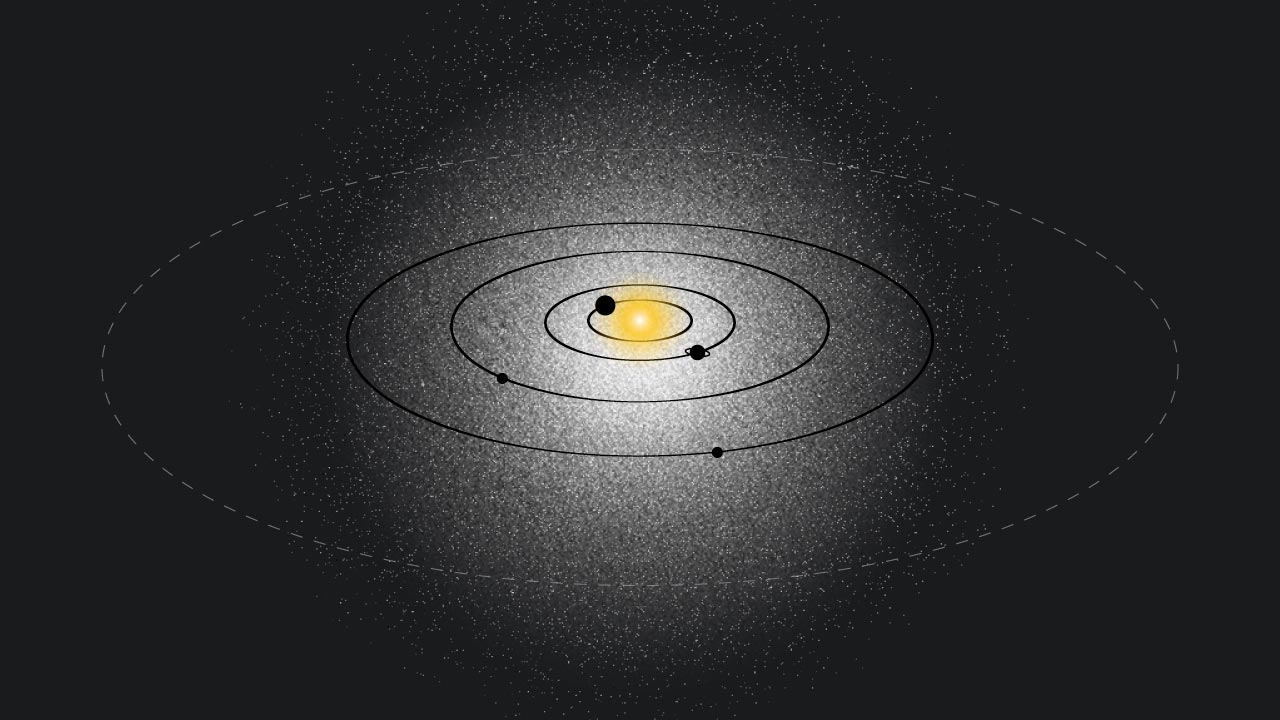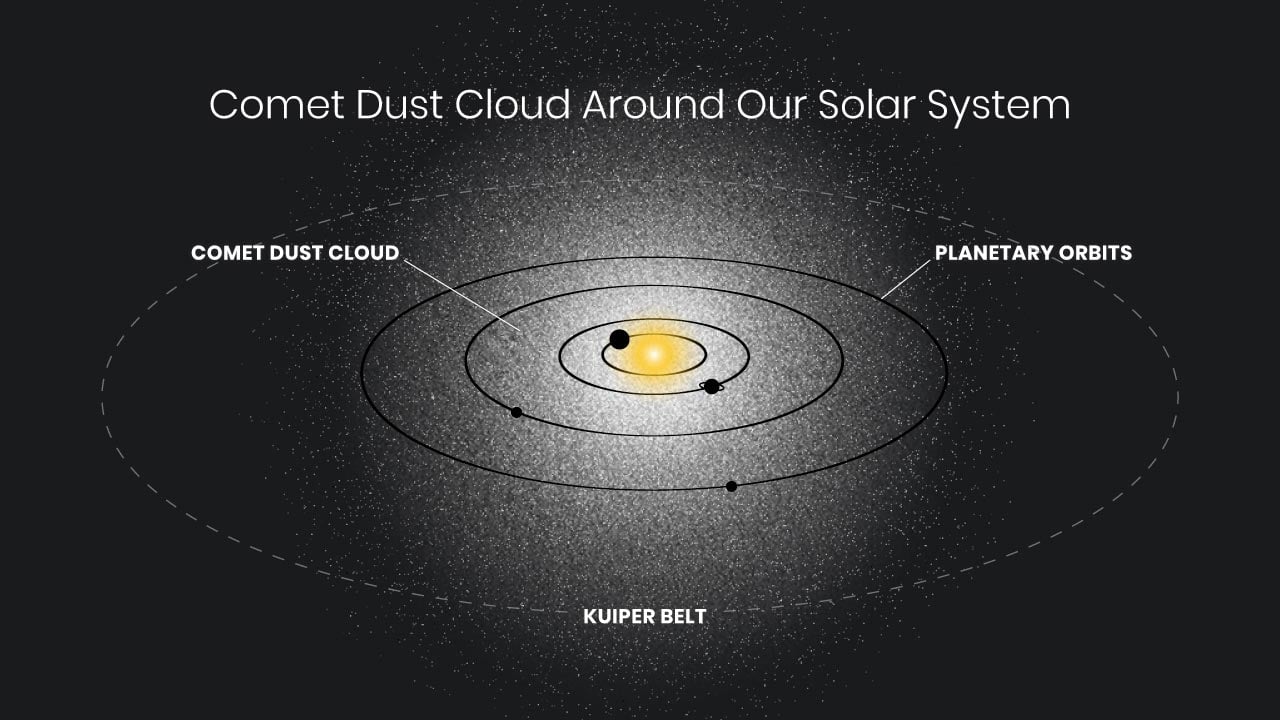
La ilustración de este artista muestra la ubicación y el tamaño de una hipotética nube de polvo que rodea nuestro sistema solar. Crédito: NASA, ESA y Andi James (STScI)
El escape de los cometas en llamas convierte el espacio en un lugar polvoriento
Imagina entrar en una habitación por la noche, apagar todas las luces y cerrar las cortinas. Sin embargo, un brillo extraño proviene de las paredes, el techo y el piso. La luz es tenue, apenas lo suficiente para ver tus manos frente a tu cara, pero continúa.
¿Suena como una escena de “Ghost Hunters”? No, este es el verdadero negocio para los astrónomos. Sin embargo, buscar algo cercano a la nada no es fácil. Los astrónomos buscaron 200.000 imágenes de archivo telescopio espacial Hubble Se realizaron decenas de miles de mediciones de estas imágenes, en busca de cualquier brillo de fondo restante en el cielo. Como si apagaran las luces de una habitación, sustraían la luz de las estrellas, galaxias, planetas e incluso la luz zodiacal. (La luz zodiacal es el débil resplandor de la luz solar difusa dispersada por el polvo interplanetario). Sorprendentemente, un débil resplandor fantasmal quedó atrás. Es equivalente a la luz constante de diez luciérnagas esparcidas por el cielo.
¿De donde viene esto?
Una posible explicación es que una capa de polvo envuelve todo el sistema solar[{” attribute=””>Pluto, and is reflecting sunlight. Seeing airborne dust caught in sunbeams is no surprise when cleaning the house. But this must have a more exotic origin. Because the glow is so smoothy distributed, the likely source is innumerable comets – free-flying dusty snowballs of ice. They fall in toward the Sun from all different directions, spewing out an exhaust of dust as the ices sublimate due to heat from the Sun. If real, this would be a newly discovered architectural element of the solar system. It has remained invisible until very imaginative and curious astronomers, and the power of Hubble, came along.

This artist’s illustration shows the location and size of a hypothetical cloud of dust surrounding our solar system. Astronomers searched through 200,000 images and made tens of thousands of measurements from Hubble Space Telescope to discover a residual background glow in the sky. Because the glow is so smoothly distributed, the likely source is innumerable comets – free-flying dusty snowballs of ice. They fall in toward the Sun from all different directions, spewing out an exhaust of dust as the ices sublimate due to heat from the Sun. If real, this would be a newly discovered architectural element of the solar system. Credit: NASA, ESA, Andi James (STScI)
Hubble Space Telescope Detects Ghostly Glow Surrounding Our Solar System
Aside from a tapestry of glittering stars, and the glow of the waxing and waning Moon, the nighttime sky looks inky black to the casual observer. But how dark is dark?
To find out, astronomers decided to sort through 200,000 images from NASA’s Hubble Space Telescope and made tens of thousands of measurements on these images to look for any residual background glow in the sky, in an ambitious project called SKYSURF. This would be any leftover light after subtracting the glow from planets, stars, galaxies, and from dust in the plane of our solar system (called zodiacal light).
When researchers completed this inventory, they found an exceedingly tiny excess of light, equivalent to the steady glow of 10 fireflies spread across the entire sky. That’s like turning out all the lights in a shuttered room and still finding an eerie glow coming from the walls, ceiling, and floor.

This photo shows the zodiacal light as it appeared on March 1, 2021, in Skull Valley, Utah. The Pleiades star cluster is visible near the top of the light column. Mars is just below that. Credit: NASA/Bill Dunford
The researchers say that one possible explanation for this residual glow is that our inner solar system contains a tenuous sphere of dust from comets that are falling into the solar system from all directions, and that the glow is sunlight reflecting off this dust. If real, this dust shell could be a new addition to the known architecture of the solar system.
This idea is bolstered by the fact that in 2021 another team of astronomers used data from NASA’s New Horizons spacecraft to also measure the sky background. New Horizons flew by Pluto in 2015, and a small Kuiper belt object in 2018, and is now heading into interstellar space. The New Horizons measurements were done at a distance of 4 billion to 5 billion miles from the Sun. This is well outside the realm of the planets and asteroids where there is no contamination from interplanetary dust.
New Horizons detected something a bit fainter that is apparently from a more distant source than Hubble detected. The source of the background light seen by New Horizons also remains unexplained. There are numerous theories ranging from the decay of dark matter to a huge unseen population of remote galaxies.
“If our analysis is correct there’s another dust component between us and the distance where New Horizons made measurements. That means this is some kind of extra light coming from inside our solar system,” said Tim Carleton, of Arizona State University (ASU).
“Because our measurement of residual light is higher than New Horizons we think it is a local phenomenon that is not from far outside the solar system. It may be a new element to the contents of the solar system that has been hypothesized but not quantitatively measured until now,” said Carleton.
Hubble veteran astronomer Rogier Windhorst, also of ASU, first got the idea to assemble Hubble data to go looking for any “ghost light.” “More than 95% of the photons in the images from Hubble’s archive come from distances less than 3 billion miles from Earth. Since Hubble’s very early days, most Hubble users have discarded these sky-photons, as they are interested in the faint discrete objects in Hubble’s images such as stars and galaxies,” said Windhorst. “But these sky-photons contain important information which can be extracted thanks to Hubble’s unique ability to measure faint brightness levels to high precision over its three decades of lifetime.”
A number of graduate and undergraduate students contributed to project SKYSURF, including Rosalia O’Brien, Delondrae Carter and Darby Kramer at ASU, Scott Tompkins at the University of Western Australia, Sarah Caddy at Macquarie University in Australia, and many others.
The team’s research papers are published in The Astronomical Journal and The Astrophysical Journal Letters.
References:
“SKYSURF: Constraints on Zodiacal Light and Extragalactic Background Light through Panchromatic HST All-sky Surface-brightness Measurements: II. First Limits on Diffuse Light at 1.25, 1.4, and 1.6 µm” by Timothy Carleton, Rogier A. Windhorst, Rosalia O’Brien, Seth H. Cohen, Delondrae Carter, Rolf Jansen, Scott Tompkins, Richard G. Arendt, Sarah Caddy, Norman Grogin, Scott J. Kenyon, Anton Koekemoer, John MacKenty, Stefano Casertano, Luke J. M. Davies, Simon P. Driver, Eli Dwek, Alexander Kashlinsky, Nathan Miles, Nor Pirzkal, Aaron Robotham, Russell Ryan, Haley Abate, Hanga Andras-Letanovszky, Jessica Berkheimer, Zak Goisman, Daniel Henningsen, Darby Kramer, Ci’mone Rogers and Andi Swirbul, 4 October 2022, The Astronomical Journal.
DOI: 10.3847/1538-3881/ac8d02
“SKYSURF: Constraints on Zodiacal Light and Extragalactic Background Light through Panchromatic HST All-sky Surface-brightness Measurements. I. Survey Overview and Methods” by Rogier A. Windhorst, Timothy Carleton, Rosalia O’Brien, Seth H. Cohen, Delondrae Carter, Rolf Jansen, Scott Tompkins, Richard G. Arendt, Sarah Caddy, Norman Grogin, Anton Koekemoer, John MacKenty, Stefano Casertano, Luke J. M. Davies, Simon P. Driver, Eli Dwek, Alexander Kashlinsky, Scott J. Kenyon, Nathan Miles, Nor Pirzkal, Aaron Robotham, Russell Ryan, Haley Abate, Hanga Andras-Letanovszky, Jessica Berkheimer, John Chambers, Connor Gelb, Zak Goisman, Daniel Henningsen, Isabela Huckabee, Darby Kramer, Teerthal Patel, Rushabh Pawnikar, Ewan Pringle, Ci’mone Rogers, Steven Sherman, Andi Swirbul and Kaitlin Webber, 15 September 2022, The Astronomical Journal.
DOI: 10.3847/1538-3881/ac82af
“SKYSURF-3: Testing Crowded Object Catalogs in the Hubble eXtreme Deep Field Mosaics to Study Sample Incompleteness from an Extragalactic Background Light Perspective” by Darby M. Kramer, Timothy Carleton, Seth. H. Cohen, Rolf Jansen, Rogier A. Windhorst, Norman Grogin, Anton Koekemoer, John W. MacKenty and Nor Pirzkal, 18 November 2022, The Astronomical Journal Letters.
DOI: 10.3847/2041-8213/ac9cca
“SKYSURF-4: Panchromatic Full Sky Surface Brightness Measurement Methods and Results” by Rosalia O’Brien, Timothy Carleton, Rogier A. Windhorst, Rolf A. Jansen, Delondrae Carter, Scott Tompkins, Sarah Caddy, Seth H. Cohen, Haley Abate, Richard G. Arendt, Jessica Berkheimer, Annalisa Calamida, Stefano Casertano, Simon P. Driver, Connor Gelb, Zak Goisman, Norman Grogin, Daniel Henningsen, Isabela Huckabee, Scott J. Kenyon, Anton M. Koekemoer, Darby Kramer, John Mackenty, Aaron Robotham and Steven Sherman, 13 October 2022, Astrophysics > Instrumentation and Methods for Astrophysics.
arXiv:2210.08010
The Hubble Space Telescope is a project of international cooperation between NASA and ESA. NASA’s Goddard Space Flight Center in Greenbelt, Maryland, manages the telescope. The Space Telescope Science Institute (STScI) in Baltimore, Maryland, conducts Hubble and Webb science operations. STScI is operated for NASA by the Association of Universities for Research in Astronomy, in Washington, D.C.

“Amante de los viajes. Pionero de Twitter. Ávido gurú de la televisión. Aficionado a Internet galardonado”.

